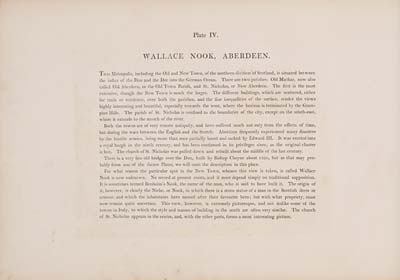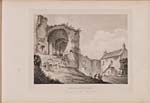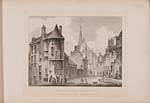(13) Plate IV/a
Download files
Individual page:
Thumbnail gallery: Grid view | List view

Plate IV.
WALLACE NOOK, ABERDEEN.THIS Metropolis,
including the Old and New Town, of the northern division of
Scotland, is situated between
the influx of the Don and the Dee into the German Ocean. There are
two parishes; Old Machar, now also
called Old Aberdeen, or the Old Town Parish, and St. Nicholas, or
New Aberdeen. The first is the most
extensive, though the New Town is much the larger. The different
buildings, which are scattered, either
for trade or residence, over both the parishes, and the fine
inequalities of the surface, render the views
highly interesting and beautiful, especially towards the west,
where the horizon is terminated by the Gram-
pian Hills. The parish of St. Nicholas is confined to the
boundaries of the city, except on the south-east,
where it extends to the mouth of the river.
Both the towns are of
very remote antiquity, and have suffered much not only from the
effects of time,
but during the wars between the English and the Scotch. Aberdeen
frequently experienced many disasters
by the hostile armies, being more than once partially burnt and
sacked by Edward III. It was erected into
a royal burgh in the ninth century, and has been confirmed in its
privileges since, as the original charter
is lost. The church of St. Nicholas was pulled down and rebuilt
about the middle of the last century.
There is a very fine old
bridge over the Don, built by Bishop Cheyne about 1320, but as that
may pro-
bably form one of the future Plates, we will omit the description
in this place.
For what reason the
particular spot in the New Town, whence this view is taken, is
called Wallace
Nook is now unknown. No record at present exists, and it must
depend simply on traditional supposition.
It is sometimes termed Benholm's Nook, the name of the man, who is
said to have built it. The origin of
it, however, is clearly the Niche, or Nook, in which there is a
stone statue of a man in the Scottish dress or
armour, and which the inhabitants have named after their favourite
hero; but with what propriety, must
now remain quite uncertain. This view, however, is extremely
picturesque, and not unlike some of the
towns in Italy, to which the style and masses of building in the
north are often very similar. The church
of St. Nicholas appears in the centre, and, with the other parts,
forms a most interesting picture.
Set display mode to:
![]() Universal Viewer |
Universal Viewer | ![]() Mirador |
Large image | Transcription
Mirador |
Large image | Transcription
Images and transcriptions on this page, including medium image downloads, may be used under the Creative Commons Attribution 4.0 International Licence unless otherwise stated. ![]()
| Scotia depicta > (13) Plate IV/a |
|---|

